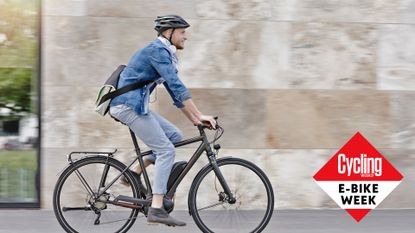14 benefits of using an electric bike - from health improvements to everyday practicalities
There are lots of value-added functions provided by many electric bikes


An electric bike is a great way of getting around and can mean that you’ll arrive at your destination more comfortable and less hot and tired than if you ride a pedal-powered bike. But the addition of a motor and the large capacity battery needed to power it means that there’s the potential to do a lot more.
E-bike system makers likeBoschand Mahle and e-bike vendors likeVanMoofhave been clever at integrating other functionality into their e-bikes to make them even more useful and user-friendly.
Here’s a run-down of functionality that some e-bikes provide. In general, it’s the high end e-bikes that provide the highest added value and not all provide everything. It’s worth checking to see if an e-bike that you’re interested in has the functions that are important to you.
1. Assistance on the flat
The most obvious benefit of riding one of thebest electric bikesis the extra assistance from the motor. That means that you can ride faster or just more easily on the flat. In most countries, assistance cuts out at 25km/h (15.5mph), but in the USA the usual cut-off speed is 20mph (it varies depending on the type of e-bike and the state).

Assistance on the flat is a significant benefit for many riders
For many riders, that means that assistance is always on, except for downhill runs when they may be travelling faster than this. They may be freewheeling downhill, so the motor will cut out in any case.
如果你一直骑在25公里/小时,你ll not get any assistance. On the other hand, you won’t be draining the battery and so you’ll get more range from your e-bike. The extra weight of the motor and battery shouldn’t make much difference to how hard it is to ride on the flat and most motors offer little or no resistance when not active.
2. Assistance on hills
Where the motor comes into its own is when you need to climb a hill. The extra assistance available makes climbs a whole lot easier; you can choose how much easier by selecting the assistance level provided by the motor.
There’s an associated benefit of arriving at the top of a climb in better shape, as you’ll not feel so much need to stop or to ride easy to recover, so you’ll be able to press on and cover more ground more quickly.

An electric bike can really help when you get to the hills
Just how much assistance is available is determined by the motor’s torque; the motor’s power output is usually limited to 250 watts for road-going e-bikes. Specialized, for example, has different motor systems it uses on different models in its e-bike range. It tags its Turbo Vado SL as 2x You, while its Turbo Vado is tagged as 4x You, indicating the difference in support available. More support means a larger motor and battery though, so the SL models are significantly lighter.
3. Faster starts
The assistance provided by the motor means faster acceleration too - particularly useful when setting off from traffic lights or stops. It’s also useful when you’re carrying a load, as it makes getting going that much easier, making an e-bike a great option for shopping trips.
4. Longer rides
If your aim isn’t so much to get help getting from A to B, but to enjoy a longer recreational ride, the addition of a motor means that you can ride further withless fatigue. Many e-bikes can manage 50-plus miles on a charge - some much further - so places that might have been out of reach on a conventional bike will be reachable. You’ll feel fresher towards the end of your ride too. Fitter riders travelling at over 25km/h might manage significantly more than the quoted range.
Often, you can fit arange extenderbattery to an e-bike, to give you even more range when you need it. It’s usually bottle shaped and designed to fit in a bottle cage.
5. Smartphone integration
There are a whole lot of features that many e-bikes, although not all, add to the basics of providing assistance to get around.

An e-bike phone app can help you plan your route and see your range
One that you can expect on the majority of e-bikes is integration with a smartphone via anapp. This can let you do a whole range of things, like check battery status. Many e-bike apps let you alter the motor set-up and tailor its output levels to meet your needs. That’s useful if, for example, you want more support to get you moving from stops or want to eke out battery capacity to extend your range.
6. Navigation
Navigationis one feature that many e-bikes have built in, either via the bar-mounted controller head unit or the smartphone e-bike app. It’s something that the best cycling computers provide too, but it’s nice to have it integrated into a single device or app rather than needing a separatecycling computerto plot where you’re going. You’ll often get turn-by-turn directions to your destination, with an alert when a turn is coming up, so you’re less likely to get lost.
Some e-bikes are designed so that you can mount your智能手机to the handlebars and use it as a controller and for navigation, or you can buy a separateweatherproof phone mountfor your bike.
7. Activity tracking

Some e-bike apps will give you lots of info on your ride
Linked to navigation is activity tracking and many e-bikes will record where you’ve ridden and how long it took. You may get additional information like effort level and calories burned. Usually this info is uploaded automatically to the e-bike’s app once you’ve completed a ride and it may also be forwarded automatically to apps likeStrava. In any case, you’ll have a diary record of where you rode, when and how far and how much effort it took.
8. Heart rate monitoring
Often an e-bike will let you layer extra data onto your activity records. Many will link up to aheart rate monitor, so that you have a record of how hard you’ve been working on your ride. In some cases, you can link the motor’s output to your heart rate, so that the motor provides extra power once your heart rate gets over a specified value. That’s useful for riders with a heart condition and also for those who only want the motor’s support when they’re working harder and who are prepared to ride under their own power at lower effort levels.
9. Weather forecasts

The Bosch Cobi e-bike app gives you weather forecasts for your route
Some e-bikes provide even more added value functions. You can buy systems that provide you with a weather forecast via a link between your smartphone and the controller, so you’re less likely to be caught out by a rainstorm.
10. Theft protection/location tracking
An additional function that some e-bikes add is an alarm or otheranti-theft protection. In some cases, the motor may be locked once this is activated so that the pedals can’t be moved, in other cases there may be a movement alarm incorporated into the e-bike.
Some e-bikes like VanMoof’s range even include a tracker, so you can locate the bike if it is stolen, or fingerprint recognition so that the e-bike can only be unlocked by its owner.
11. Walk assist

Walk assist helps you move around when you're not riding your e-bike
There’s another range of functionality that some e-bikes add to help you use them more easily. E-bikes are a bit heavier than standard bikes and can be difficult to move around, but some motor systems provide a walk assist function. When you’re not riding the bike, this operates the motor at a slow pace, so the bike helps you to move it around more easily.
12. Auto gear shifting
Some e-bike systems can be programmed to work with the bike's gears and provide automatic gear shifting. The controller senses how fast and how hard you’re pedalling and shifts gears for you. This means that you’re always pedalling at a comfortable cadence and level of exertion for the conditions and don’t have to worry about operating a shift lever.
13. Integrated lights
Rather than having separate lights that you need to remember to charge up, in some cases an e-bike will come with lighting powered by the e-bike’s main battery. This not only saves hassle, it means a lighter, more compact system overall as the lights won’t need their own batteries built into them. With its large capacity, your lights are very unlikely to run out of power. You may also be able to control the lights’ output via the e-bike’s controller.
14. USB port
Finally, an e-bike might provide one or more USB ports, so you can power up your mobile phone or other device as you ride, so there’s a lot less chance of running out of power.

Thank you for reading 10 articles this month* Join now for unlimited access
Enjoy your first month for just £1 / $1 / €1
*Read 5 free articles per month without a subscription

Join now for unlimited access
Try first month for just£1 / $1 / €1
Paul started writing for Cycling Weekly in 2015, covering cycling tech, new bikes and product testing. Since then, he’s reviewed hundreds of bikes and thousands of other pieces of cycling equipment for the magazine and the Cycling Weekly website.
He’s been cycling for a lot longer than that though and his travels by bike have taken him all around Europe and to California. He’s been riding gravel since before gravel bikes existed too, riding a cyclocross bike through the Chilterns and along the South Downs.
-
-
 Thumbtacks in road cause punctures on Tour de France 2023 stage two
Thumbtacks in road cause punctures on Tour de France 2023 stage twoRiders puncture in the Basque Country after tacks spread in the road
By Tom Davidson •Published
-
 Tour de France 2023: Victor Lafay wins stage two thanks to a brilliantly timed attack
Tour de France 2023: Victor Lafay wins stage two thanks to a brilliantly timed attackVictor Lafay wins stage two thanks to brain and legs after looking strong the day before
By Jack Elton-Walters •Published
-
 Ask a cycling coach: 'Can you get fit on an electric bike?'
Ask a cycling coach: 'Can you get fit on an electric bike?'骑着一辆电动自行车,可以正确利用improve the training process rather than being a cop out as some may think
By James Spragg •Published
-
 Cycling UK gives you the chance to loan an e-bike for a month for free
Cycling UK gives you the chance to loan an e-bike for a month for freeIf you live in Manchester, Sheffield, Leicester or Luton & Dunstable, now’s your chance to test the waters of going electric
By Anna Marie Abram •Published
-
 It’s ‘E-Bike’ week on Cycling Weekly - join us for a week of electric bike tips, advice and know-how
It’s ‘E-Bike’ week on Cycling Weekly - join us for a week of electric bike tips, advice and know-howFrom 22nd to 26th May, here at Cycling Weekly, we’ll be sharing a host of guides and explainers to help electric bike owners - or prospective owners - get the very most from their machines
By Anna Marie Abram •Published




